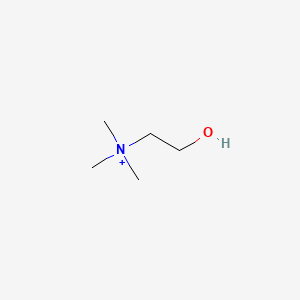



1. 2-hydroxy-n,n,n-trimethylethanaminium
2. Bitartrate, Choline
3. Bursine
4. Chloride, Choline
5. Choline Bitartrate
6. Choline Chloride
7. Choline Citrate
8. Choline Hydroxide
9. Choline O Sulfate
10. Choline O-sulfate
11. Citrate, Choline
12. Fagine
13. Hydroxide, Choline
14. O-sulfate, Choline
15. Vidine
1. Choline Ion
2. Bilineurine
3. 62-49-7
4. Choline Cation
5. 2-hydroxy-n,n,n-trimethylethanaminium
6. Cholinum
7. Ethanaminium, 2-hydroxy-n,n,n-trimethyl-
8. (2-hydroxyethyl)trimethylammonium
9. Trimethylethanolamine
10. N-trimethylethanolamine
11. Vitamin J
12. 2-hydroxyethyl(trimethyl)azanium
13. Ccris 5847
14. Ai3-24208
15. Brn 1736748
16. N,n,n-trimethylethanol-ammonium
17. Chebi:15354
18. (beta-hydroxyethyl)trimethylammonium
19. Chembl920
20. N91bdp6h0x
21. (2-hydroxyethyl)trimethylazanium
22. 2-hydroxy-n,n,n-trimethyl-ethanaminium
23. Bilineurine; Choline Cation; Choline Ion; Nanoveson C; Vitamin J
24. Cht
25. Nsc402838
26. Ncgc00015219-03
27. Einecs 200-535-1
28. Unii-n91bdp6h0x
29. 2-hydroxyethyl(trimethyl)ammonium
30. 1oba
31. 2reg
32. 3ppq
33. Choline (dcf)
34. Choline (8ci)
35. Nanoveson C
36. Spectrum_000258
37. 2ha3
38. 3r6u
39. Choline [vandf]
40. Choline [mi]
41. Spectrum2_001938
42. Spectrum4_000867
43. Spectrum5_001579
44. Lopac-c-1754
45. Choline [who-dd]
46. Bmse000285
47. Bmse000953
48. Bmse001003
49. Epitope Id:116046
50. Schembl3142
51. Lopac0_000180
52. Kbiogr_001533
53. Kbioss_000738
54. 3-04-00-00651 (beilstein Handbook Reference)
55. Divk1c_000107
56. N,n,n-trimethylethanolammonium
57. Spbio_001975
58. Gtpl4551
59. Dtxsid8043789
60. Kbio1_000107
61. Kbio2_000738
62. Kbio2_003306
63. Kbio2_005874
64. Nsc6393
65. Ninds_000107
66. (2-hydroxyethyl)trimethyl Ammonium
67. Mono-2-hydroxyethyltrimethylammonium
68. Nsc-6393
69. Zinc3079337
70. Bbl005532
71. Bdbm50026220
72. Stl137772
73. Akos005721137
74. 2-hydroxyethyl)trimethylammonium
75. Ccg-204275
76. Db00122
77. Idi1_000107
78. Ncgc00015219-01
79. Ncgc00015219-02
80. Ncgc00015219-04
81. Ncgc00015219-07
82. Ncgc00015219-10
83. Ncgc00162082-01
84. Carbachol Impurity A [ep Impurity]
85. Sbi-0050168.p003
86. 2-hydroxy-n,n,n-trimethylammonium Chloride
87. (.beta.-hydroxyethyl)trimethylammonium
88. C00114
89. D07690
90. Ab00053822_02
91. Ethanaminium, 2-hydroxy-n,n,n-trimethyl- (9ci)
92. Q193166
93. Acetylcholine Chloride Impurity A [ep Impurity]
| Molecular Weight | 104.17 g/mol |
|---|---|
| Molecular Formula | C5H14NO+ |
| XLogP3 | -0.4 |
| Hydrogen Bond Donor Count | 1 |
| Hydrogen Bond Acceptor Count | 1 |
| Rotatable Bond Count | 2 |
| Exact Mass | 104.107539070 g/mol |
| Monoisotopic Mass | 104.107539070 g/mol |
| Topological Polar Surface Area | 20.2 Ų |
| Heavy Atom Count | 7 |
| Formal Charge | 1 |
| Complexity | 46.5 |
| Isotope Atom Count | 0 |
| Defined Atom Stereocenter Count | 0 |
| Undefined Atom Stereocenter Count | 0 |
| Defined Bond Stereocenter Count | 0 |
| Undefined Bond Stereocenter Count | 0 |
| Covalently Bonded Unit Count | 1 |
For nutritional supplementation, also for treating dietary shortage or imbalance
This compound is needed for good nerve conduction throughout the CNS (central nervous system) as it is a precursor to acetylcholine (ACh). Choline is also needed for gallbladder regulation, liver function and lecithin (a key lipid) formation. Choline also aids in fat and cholesterol metabolism and prevents excessive fat build up in the liver. Choline has been used to mitigate the effects of Parkinsonism and tardive dyskinesia. Choline deficiencies may result in excessive build-up of fat in the liver, high blood pressure, gastric ulcers, kidney and liver dysfunction and stunted growth.
Lipotropic Agents
Endogenous factors or drugs that increase the transport and metabolism of LIPIDS including the synthesis of LIPOPROTEINS by the LIVER and their uptake by extrahepatic tissues. (See all compounds classified as Lipotropic Agents.)
Nootropic Agents
Drugs used to specifically facilitate learning or memory, particularly to prevent the cognitive deficits associated with dementias. These drugs act by a variety of mechanisms. (See all compounds classified as Nootropic Agents.)
Choline has known human metabolites that include Trimethylazanium and acetaldehyde.
S73 | METXBIODB | Metabolite Reaction Database from BioTransformer | DOI:10.5281/zenodo.4056560
Choline is a major part of the polar head group of phosphatidylcholine. Phosphatidylcholine's role in the maintenance of cell membrane integrity is vital to all of the basic biological processes: information flow, intracellular communication and bioenergetics. Inadequate choline intake would negatively affect all these processes. Choline is also a major part of another membrane phospholipid, sphingomyelin, also important for the maintenance of cell structure and function. It is noteworthy and not surprising that choline deficiency in cell culture causes apoptosis or programmed cell death. This appears to be due to abnormalities in cell membrane phosphatidylcholine content and an increase in ceramide, a precursor, as well as a metabolite, of sphingomyelin. Ceramide accumulation, which is caused by choline deficiency, appears to activate Caspase, a type of enzyme that mediates apoptosis. Betaine or trimethylglycine is derived from choline via an oxidation reaction. Betaine is one of the factors that maintains low levels of homocysteine by resynthesizing L-methionine from homocysteine. Elevated homocysteine levels are a significant risk factor for atherosclerosis, as well as other cardiovascular and neurological disorders. Acetylcholine is one of the major neurotransmitters and requires choline for its synthesis. Adequate acetylcholine levels in the brain are believed to be protective against certain types of dementia, including Alzheimer's disease.